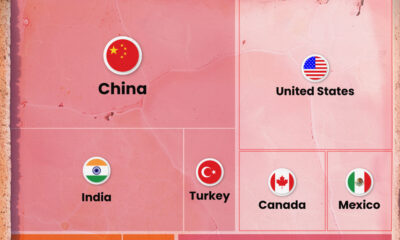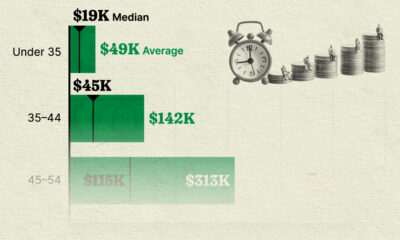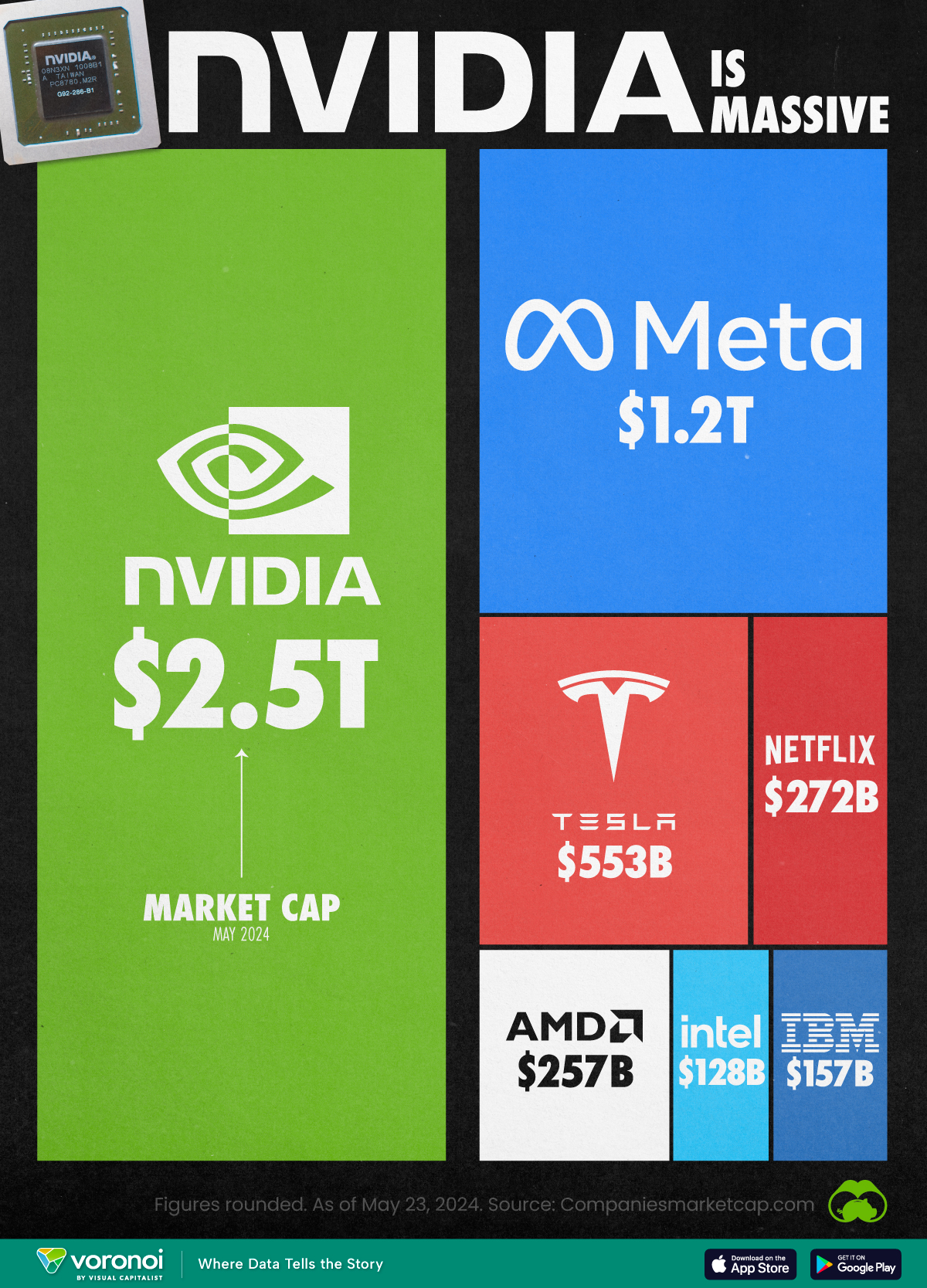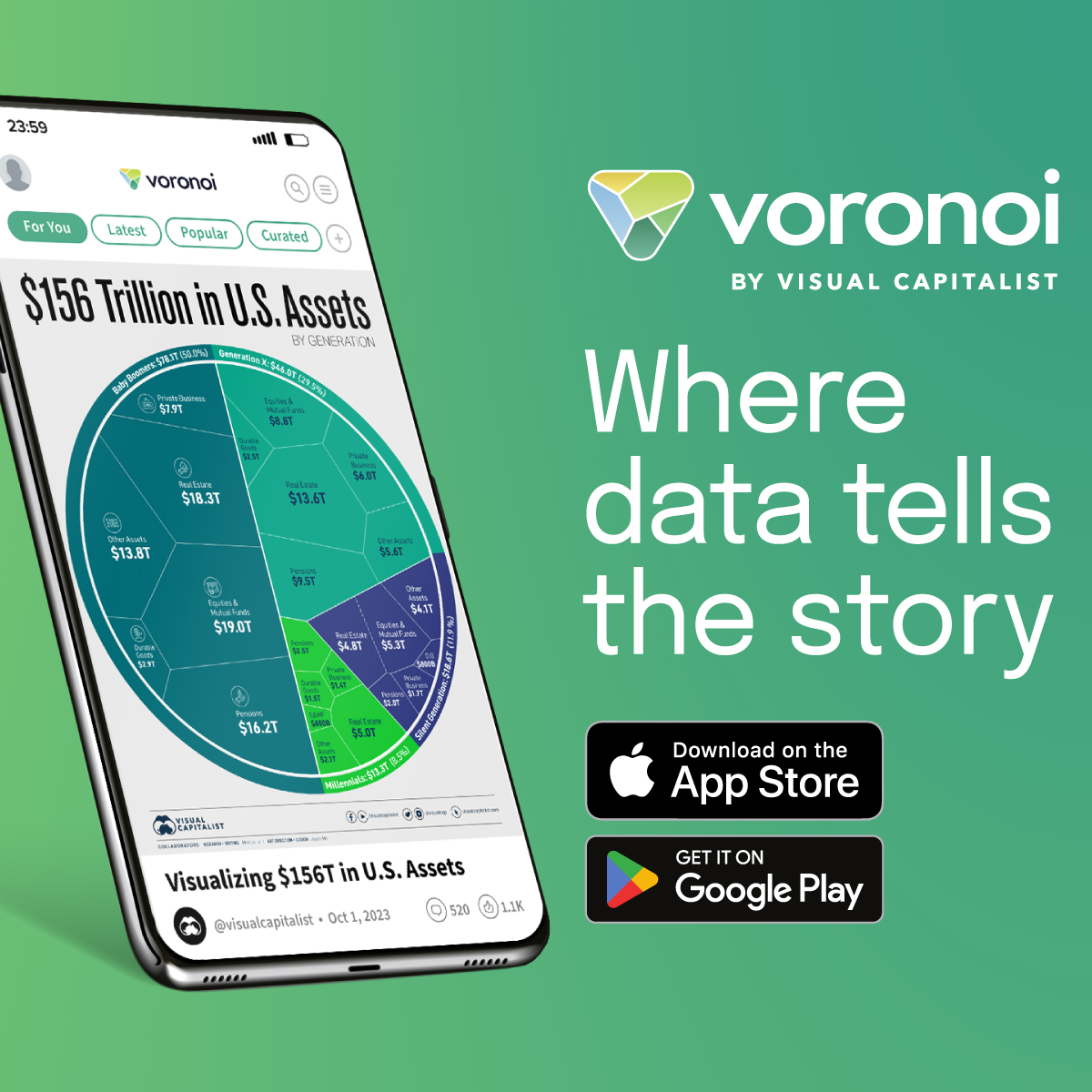Technology
Internet Browser Market Share (1996–2019)
Internet Browser Market Share (1996–2019)
Web browsers are a ubiquitous part of the internet experience and one of the most commonly used digital tools of the modern era.
Since the first rudimentary interfaces were created in the 1990s, a number of browsers have entered the market, with a select few achieving market dominance over our access to web content.
Today’s bar chart race video, by the YouTube channel Data is Beautiful, is a nostalgic look back at how people used to access the internet, from Mosaic to Chrome.
The First Wave of Browsers
Simply put, web browsers are the software applications that act as our portal to the internet. Today, aside from the occasional pop-up box, we barely notice them. In the early ’90s though, when the web was in its infancy, the crude, boxy interfaces were a revolutionary step in making the internet usable to people with access to a computer.
The first step in this journey came in 1990, when the legendary Tim Berners-Lee developed the first-ever web browser called “WorldWideWeb” – later renamed Nexus. Nexus was a graphical user interface (GUI) that allowed users to view text on web pages. Images were still beyond reach, but since most connections were dial-up, that wasn’t much of a limitation at the time.

The precurser to the modern browser was Mosaic, originally developed as a temporary project by the the University of Illinois at Urbana–Champaign (UIUC) and the National Center for Supercomputing Applications (NCSA).
After his graduation from UIUC in 1993, Marc Andreessen teamed up with Jim Clark, the founder of Silicon Graphics, to produce a commercial version of the browser. The resulting software, Netscape Navigator, became the first widely used browser, moving the internet from an abstract concept to a network that was accessible to everyday people. The company soon staged a wildly popular IPO, which saw the 16-month-old startup reach a valuation of nearly $3 billion.
Naturally, the fanfare surrounding Netscape had captured Microsoft’s attention. Immediately after Netscape’s IPO, the first version of Internet Explorer (building off a licensed version of Mozilla) was released. The browser wars had begun.
The Internet Explorer Era
In 1995, Bill Gates was looking to capitalize on the “Internet Tidal Wave”, and was up to the challenge of eating into Netscape’s market share, which stood at about 90%.
A new competitor “born” on the Internet is Netscape. We have to match and beat their offerings…
– Bill Gates
Ultimately, Netscape was no match for Internet Explorer (IE) once it was bundled with the Windows operating system. By the dawn of the new millennium (beware Y2K!) the situation had reversed, with IE capturing over 75% of the browser market share.
With Netscape mostly out of the picture, IE had a stranglehold on the market. In fact, Microsoft’s position was so comfortable that after IE6 was released 2001, the next full version wouldn’t ship until 2006.
It was during this time that a new player came onto the scene. Mozilla Firefox was officially launched in 2004, seeing over 60 million downloads within its first nine months. For the first time in years, Microsoft began to feel the heat of competition.
Goliath and Goliath
Despite the growing popularity for Mozilla Firefox, it was a browser backed by another tech giant that would eventually lead to IE’s downfall – Google Chrome.
Chrome was pitched to the public in 2008 as “a fresh take on the browser”. While Microsoft struggled with open web standards, Chrome’s source code was openly available through Google’s Chromium project.
By 2011, Firefox and Chrome had eroded IE’s market share to below 50%, and a year later, Chrome would end Internet Explorer’s 14-year reign as the world’s top internet browser.
Today, the browser market has come full circle. Chrome has now become the dominant browser on the market, while competitors fight to increase their single-digit market shares. IE has dropped to fourth place.
Looking Back at the Peaks
In the 25 years since Netscape gave people access to the internet, a few browsers have had their moment in the sun. Here are the years of peak market share for all the major browsers:
| Browser | Peak Market Share | Peak Year |
|---|---|---|
| Netscape Navigator | 90% | 1995 |
| Internet Explorer | 95% | 2004 |
| Opera | 3% | 2009 |
| Mozilla Firefox | 32% | 2010 |
| Safari | 7% | 2012 |
Once a browser becomes popular, it can be incredibly difficult to carve into its market share. Even during the height of the iPhone era, Apple’s browser, Safari, was only able to manage a 7% market share.
For now, it looks like Chrome will continue to be the world’s preferred method of experiencing the internet. If Chrome’s current trajectory continues, it could become the third major browser to surpass a 90% market share.
Technology
Nvidia is Worth More Than All of These Companies Combined
Gain a unique perspective on the market cap of Nvidia in this simple graphic.

Putting the Market Cap of Nvidia Into Perspective
This was originally posted on our Voronoi app. Download the app for free on iOS or Android and discover incredible data-driven charts from a variety of trusted sources.
Nvidia’s massive rise in the AI era has been well-documented, but did you know that it’s currently the world’s third most valuable company?
To put the massive market cap of Nvidia into perspective, we’ve put it side by side with a collection of other major U.S. tech companies.
All figures were sourced from Companiesmarketcap.com, and are as of May 23, 2024.
Data and Takeaways
All of the numbers we used to create this graphic are included in the table below.
| Company | Market Cap (as of May 23, 2024) |
|---|---|
| Nvidia | $2.5T |
| Meta | $1.2T |
| Tesla | $553B |
| Netflix | $272B |
| AMD | $257B |
| Intel | $128B |
| IBM | $157B |
These figures are even more impressive when you consider that at the beginning of 2020, Nvidia was valued at a relatively tiny $145 billion.
Since then, the company has greatly surpassed other American chipmakers like Intel and AMD. This growth is due to several key factors:
- Expansion into AI and data centers: Nvidia’s chips are highly effective for AI training, making them essential for companies engaged in machine learning and generative AI
- Advancements in AI software: Nvidia has developed AI software platforms, such as CUDA-X and TensorRT, which are widely used by researchers.
- Strong financial performance: Nvidia has consistently delivered strong financial results in recent years, with substantial revenue growth.
Closing in on Apple
With Nvidia’s latest stock surge (up 13.5% over the past five days ending May 24, 2024), the company could possibly overtake Apple to become the world’s second most valuable company.
Microsoft, another major player in AI, holds the #1 spot with a market cap of $3.2 trillion.
See More Visuals on Nvidia
If you enjoyed this graphic, be sure to check out this graphic that breaks down Nvidia’s revenue by product line, from 2019 to 2024.
-

 Countries2 weeks ago
Countries2 weeks agoRanked: Countries Where Youth are the Most Unhappy, Relative to Older Generations
-

 Cannabis2 weeks ago
Cannabis2 weeks agoMapped: Countries Where Recreational Cannabis is Legal
-

 Brands2 weeks ago
Brands2 weeks agoCharted: How the Logos of Select Fashion Brands Have Evolved
-

 population2 weeks ago
population2 weeks agoMapped: U.S. States By Number of Cities Over 250,000 Residents
-

 Crime2 weeks ago
Crime2 weeks agoVisualizing Global Losses from Financial Scams
-

 Mining2 weeks ago
Mining2 weeks agoThe Biggest Salt Producing Countries in 2023
-

 United States2 weeks ago
United States2 weeks agoRanked: The Top 6 Economies by Share of Global GDP (1980-2024)
-

 Money2 weeks ago
Money2 weeks agoVisualizing America’s Average Retirement Savings, by Age




